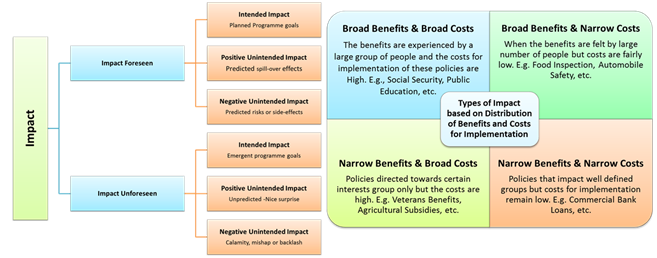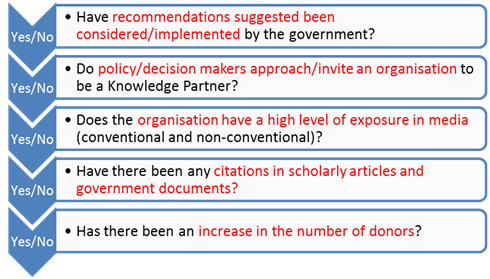[Editor’s note: This article was first published in Politics&Ideas.]
The term think tank was first used during World War II to describe a safe space to plan and discuss military strategies. Over the years, the meaning of think tanks including their role has changed. Today, think tanks are considered Public Policy Research, Analysis and Engagement Organisations in most countries. They play a critical role in political and policy arenas, not only at domestic levels, but also on an international scale.
For more on think tank definitions check-out the On Think Tanks Series on Think Tanks: Definition and Terminology
But how do we determine what a successful think tank is? How does one measure the performance of a think tank?
Since the main objective of a think tank is to provide decision makers with high quality and objective policy research on policy relevant subjects, then, one important element of success should “policy impact”.
Defining Policy Impact
Different organisations have defined policy impact in their own ways.
One way to think about it is from the perspective of funders and their projects. For instance, the World Health Organization defines impact as “improved health outcomes achieved”. The Department for International Development (DFID) defines it as “the demonstrable contribution that excellent research makes to society and the economy”. This definition has now been adapted by several organisations in the UK. Finally, the European Commission describes impact as “all the changes which are expected to happen due to the implementation and application of a given policy option/intervention”.
Several organisations/institutes have defined policy impact based on their own missions or goals and then specified appropriate methods to measure it.
Types of Policy Impact
Popular studies classify impact as academic or non-academic, intended or unintended, foreseen or unforeseen. Most researchers focus on the extent of the policy benefits – broad or narrow, and the cost for its implementation. Some are classified based on time. It could be short-term individual impact or long-term collective impact. A brief overview is provided by the following graph.

Policy Impact Parameters
Organisations and think tanks often debate on what could be defined as or label as policy impact. Think tanks are usually supported by grants from donors who naturally like to see visible impacts of their investments. Similarly, the research staff of these organisations are keen to ensure that policymakers take note of the research conducted by them. This has led to acknowledging the need to measure policy impact.
However, as there is a large diversity in the nature of think tanks, it is difficult to have one single metric of impact. Some of the broad plausible parameters are summarised as follows. We emphasise that this is not an exhaustive list and there could be more metrics as well.

If the answer to one or more of the questions mentioned above is “Yes”, then it could be said that the organisation has indeed made an impact. This is perhaps can be a simple method of measuring impact but it is important to highlight that in a healthy democracy, the policymaking process involves inputs from a large number of stakeholders, and think tanks are just one of them. Ideally a think tank can set goals with reference to their work/research and also ensure that these goals are relevant for decision makers.
Indian Scenario
India is among the countries with most think tanks in the world. In recent years, there has been a steady increase in the number of Indian think tanks and also a gradual increase in their engagement with the government. For a long time, policymaking was confined within the Ministries and the Civil Service. However, this is now changing. Several ministries actively engage with think tanks for their expertise and solicit inputs for framing and implementing policy.
The government relies on these think tanks for both quick, short-term analyses and long-term studies. Indian businesses have also begun investing in and establishing such institutions.
There are several illustrations of the important role played by Indian think tanks in shaping policy in various disciplines -which can be described as impact. These include India’s nuclear policy, foreign policy, climate and low carbon policy, etc. For example, CSTEP has been chosen as the only non-government organisation in an Expert Committee to evolve a strategy for self-reliance in critical strategic resource of Rare Earths, constituted by NITI Aayog. The said strategy will focus on individual Rare Earth Metals from mineral exploration to manufacturing end products.
Conclusion
As the think tank ecosystem in India continues to flourish, it is imperative to measure the efficacy of these organisations based on their work and interest. Most Indian think tanks have begun to realise the usefulness of measuring policy impact and there needs to be more clarity on tangible policy impact measurement indices.

